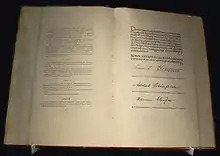Adolph Schönfelder | |
|---|---|
| Second Mayor of the Free and Hanseatic city of Hamburg | |
| In office 1945–1946 | |
| Preceded by | – |
| Succeeded by | Christian Koch |
| Father of the House of the Parlamentarischer Rat | |
| In office 1948–1949 | |
| Personal details | |
| Born | 1875 Hamburg |
| Died | 1966 Hamburg |
| Nationality | German |
| Political party | Social Democratic Party of Germany |
Heinrich Ferdinand Adolph Schönfelder (1875–1966) was a German politician, Alterspräsident (President by right of age, Father of the House) of the Federal German parliamentary council in 1948–49, mayor of Hamburg, and member of the Hamburg Parliament. Schönfelder was member of the Social Democratic Party.
From 1921 to 1925, Schönfelder was the president of the Central Union of Carpenters and Kindred Trades of Germany.[1]
On 1 September 1948 in his position of Alterspräsident, Schönfelder presided over the first meeting of the Parliamentary Council that drafted the Basic Law for the Federal Republic of Germany. As presiding officer of the constitutive meeting of the parliamentary council, he chaired the election of the council's President and two Vice-Presidents. He was chosen first vice-president of the council.
On 23 May 1949, as first vice-president of the parliamentary council, he signed the Basic Law for the Federal Republic of Germany together with Konrad Adenauer and Hermann Schäfer.
Schönfelder was honorary citizen of Hamburg, the highest decoration of the city-state.[2]

See also
References
- ↑ Wolgast, Wilhelm (1931). Zentralverband der Zimmerer und verwandter Berufsgenossen. ADGB. pp. 2111–2112. Retrieved 29 May 2020.
- ↑ Honored 1950 — "Hamburgische Ehrenbürger" (in German). Government of Hamburg. Archived from the original on 7 October 2009. Retrieved 2009-10-06.
For merits to the common good and constructive cooperation between the ruling majority and opposition
External links
- Adolph Schönfelder in the German National Library catalogue
- Newspaper clippings about Adolph Schönfelder in the 20th Century Press Archives of the ZBW